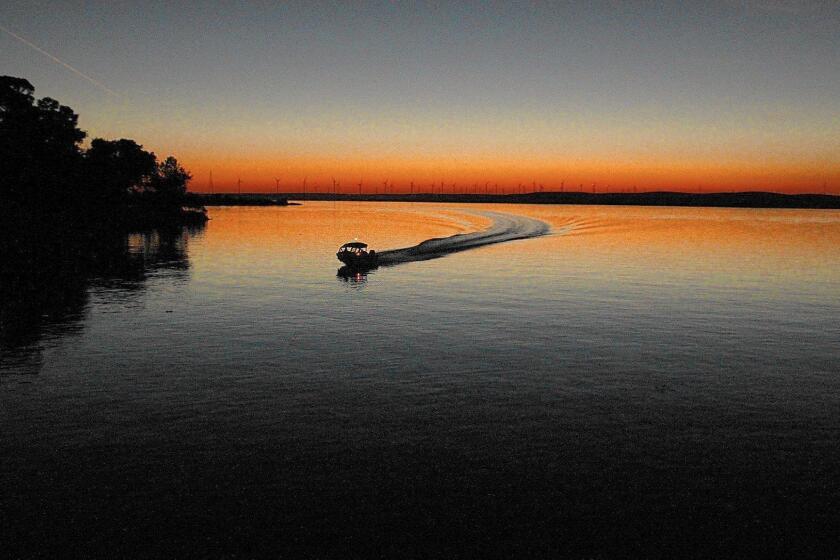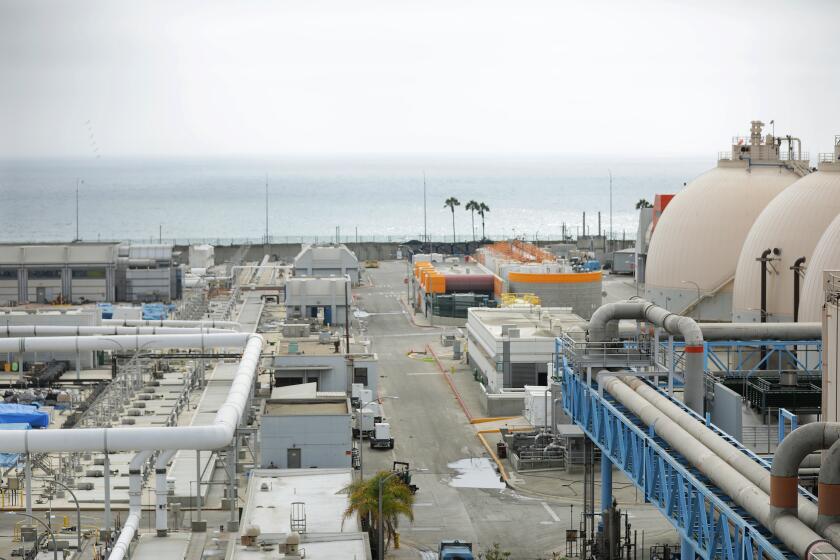Study of U.S. oil refineries ranks Chevron El Segundo as worst emitter of two water pollutants

- Share via
A study of oil refineries nationwide ranked the Chevron El Segundo facility on Santa Monica Bay as the largest water polluter for nitrogen and selenium in 2021, compared to 80 other oil operations.
The pollutants, which are byproducts of the oil refining process, are legally discharged into the Pacific Ocean. Authors of the report, as well as conservationists, are calling on federal environmental officials to revise and tighten regulations that permit such discharges into water bodies, saying they have the power to do so but choose not to act.
“Once again, the U.S. government has turned a blind eye while oil and gas companies pollute our environment, including our sensitive marine ecosystems, and disproportionately harm our front-line communities,” Los Angeles Waterkeeper Executive Director Bruce Reznik said in a news release. “We must now put the spotlight on oil refineries’ essentially unregulated water pollution and demand that [the Environmental Protection Agency] fulfill its duty under the Clean Water Act by setting, updating and actually enforcing discharge limits for these refineries.”
In an email to The Times, the oil company said it directly treats all of the facility’s process wastewater and storm water runoff “under a rigorous discharge permit (known as a National Pollutant Discharge Elimination System or ‘NPDES’ permit) issued by the Los Angeles Regional Water Quality Control Board,” adding that it remains in compliance with federal, state and local water regulatory standards.
“Chevron built the capacity to operate, permit and treat all its wastewater and storm water runoff, rather than place a burden on Publicly Owned Treatment Works,” the statement said, referring to treatment plants owned by government agencies.
The report, released Thursday by the nonprofit Environmental Integrity Project, also ranked Chevron Richmond and PBF Martinez (formerly Shell) refineries in Northern California among the top 10 nickel polluters among national refineries, ranking at No. 5 and No. 10, respectively.
It also found that two-thirds of the 81 refineries analyzed are disproportionately located in low-income areas, and that more than half “are in areas where the percentage of people of color exceeds the national average.” Of those 81, nearly 70% have contributed to downstream waterways that are too contaminated to sustain aquatic life or to safely swim or fish in, the report said.
In a press conference Thursday, Eric Schaeffer, the Environmental Integrity Project’s executive director and former director of the EPA’s Office of Civil Enforcement, said he remembers how bad pollution was in the U.S. before the Clean Water Act was enacted more than 50 years ago, which promised that our public waters would be safe to fish and swim in within a few years.
“We’ve long passed that deadline,” he said. “We’ve seen real improvements since then but our progress has stalled. Based on the most recent state surveys, about half our rivers and lakes, and at least a quarter of our estuaries are so polluted, they’re unhealthy for fish and aquatic life, and they’re not safe for swimming or other recreation activities. These are not, to put it simply, the fishable and swimmable waters we were promised.”
Schaeffer blamed conditions on the government’s failure to demand that oil refineries and other industrial dischargers use modern treatment systems — technological updates that could reduce the volume and toxicity of the pollutants they dump.
“The waters, after all, belong to the public and not private companies,” he said.

The Clean Water Act, enacted in 1948 under a different name and restructured in 1972, regulates water pollution in the United States. Its purpose, in part, is to restore and maintain the nation’s waters.
But the report alleges that the EPA, which manages the Clean Water Act’s laws and regulations, has failed to enforce it. Among the EPA’s responsibilities is to reduce the dumping of pollutants and to toughen those limits at least twice every decade if treatment technology has improved.
“But the standards for refineries have not been revised in nearly four decades, since 1985, and apply to only a small handful of pollutants,” the report alleges. “These weak and outdated standards do not reflect advances in treatment methods or the expansion and modification of refinery operations over the last four decades. While a few state agencies have included several additional discharge limits in refinery wastewater permits, EPA and state environmental agencies rarely enforce them or penalize violations.”
The Environmental Integrity Project evaluated EPA’s data on enforcement and compliance and discovered that more than 80% of the 81 refineries reported exceeding their permitting limits on water toxins at least once between 2019 and 2021. Yet most were not penalized.
In an email, the EPA said it is aware of the report and will “review and respond accordingly.”
In 2021, Chevron El Segundo released 1.6 million pounds of nitrogen into Santa Monica Bay, according to the Environmental Integrity Project, which analyzed the oil industry’s toxic release reports, permit applications and its monitoring data to compile their findings. It also released 5,257 pounds of selenium, according to the report.
Tracy Quinn, president and chief executive of Heal the Bay, called the nitrogen numbers “worrisome.”
“While there are no acute health concerns for swimmers and surfers” because the dumping is far enough from shore, “discharges of nitrogen into our coastal waters can have serious impacts on our marine life,” she said in an email. She cited the California Ocean Acidification Action Plan, which states that nutrients such as nitrogen can exacerbate ocean acidification when discharged into coastal waters.
Quinn also noted that the Hyperion Water Reclamation Plant in Playa del Rey currently discharges more than 20 times the amount of nitrogen annually into Santa Monica Bay than Chevron El Segundo. She said Hyperion plans to reduce its nitrogen discharges to 1.7 million pounds per year when it upgrades facilities to produce recycled water.
Just in the San Francisco Bay, four refineries — including Valero Benicia and Phillips 66 Rodeo — released into tributaries at least 1,057 pounds of selenium, 1.2 million pounds of nitrogen, 32,298 pounds of oil and grease, and thousands of more pounds of other pollutants such as arsenic and lead, the report says.
Half a century after Congress adopted the Clean Water Act, the nation’s waterways remain at risk and are facing new challenges.
Collectively, the 81 refineries studied across the country dumped 1.6 billion pounds of chlorides, sulfates and other dissolved solids into waterways in 2021. Some 60,000 pounds of selenium and 15.7 million pounds of nitrogen, among other pollutants, were also discharged.
Study authors say that contamination could have grave consequences for wildlife and ecosystems. At high levels, many of the toxins can cause reproductive damage to fish and birds. Chloride can also kill fish and plants. Too much nitrogen can trigger algae to grow excessively, depriving aquatic life of oxygen and clogging rivers and streams. It can also be harmful to young children and livestock that consume drinking water with excessive nitrogen.
Research shows that high levels of selenium are causing spinal deformities in more than 80% of young Sacramento splittail, a freshwater fish, in the Bay area.
The toxic metal occurs naturally in crude oil and can kill off entire fish populations and cause mutations and reproductive damage. It can also harm birds, amphibians and other animals that feed on aquatic life.
The report also found that many U.S. refineries “have antiquated and inadequate pollution control systems’’ due to their age — they average 74 years but some are as old as 140 years. It also alleges that the EPA has not updated its limits for refineries in nearly 40 years despite their growth over the last several decades, “increasing both the volume and variety of pollutants they discharge.”
“What are we asking for?” Schaeffer said to reporters. “No more than what the Clean Water Act has required since the 1970s. We ask EPA to comply with the law, rise to the occasion, and write new standards based on the more advanced treatments systems we have in this century instead of the ones we should’ve left behind in the last one.”
Even as flooding at a major Los Angeles sewage plant threatened the lives of workers, communication failures masked the enormity of the crisis.
The findings evoke memories of L.A.’s massive sewage spill of 2021, when the Hyperion plant dumped millions of gallons of untreated sewage into Santa Monica Bay.
Residents of the area complained about skin rashes, headaches and nausea for weeks, and the incident spawned two lawsuits against sanitation officials and triggered dozens of violation notices from regulators.
The likely causes of the spill were multiple equipment failures, unheeded alarms of rising wastewater and insufficient staffing.
The official report that analyzed what caused the spill noted, among other things, that sanitation officials needed to upgrade equipment at the city’s oldest and largest wastewater treatment facility.
Times staff writer Robert J. Lopez contributed to this report.
More to Read
Sign up for Essential California
The most important California stories and recommendations in your inbox every morning.
You may occasionally receive promotional content from the Los Angeles Times.













